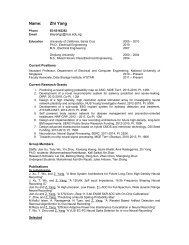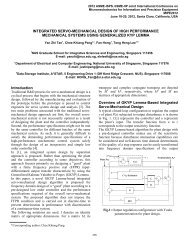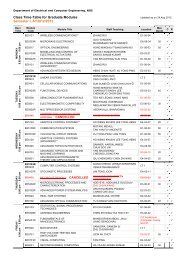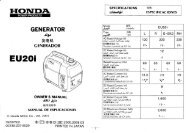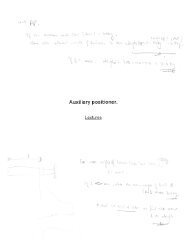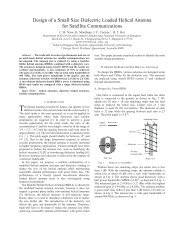Development and evolution of MOEMS technology in variable ...
Development and evolution of MOEMS technology in variable ...
Development and evolution of MOEMS technology in variable ...
Create successful ePaper yourself
Turn your PDF publications into a flip-book with our unique Google optimized e-Paper software.
Lee <strong>and</strong> Yeh: <strong>Development</strong> <strong>and</strong> <strong>evolution</strong> <strong>of</strong> <strong>MOEMS</strong> <strong>technology</strong>…<br />
Fig. 14 Histogram <strong>of</strong> the mean value distribution <strong>of</strong> measured data from each <strong>in</strong>dividual channel <strong>of</strong> multichanneled VOAs us<strong>in</strong>g a retrorefractive<br />
attenuation scheme relative to their PDL <strong>and</strong> BRL characteristics, where a <strong>and</strong> d represent the data measured at 10-dB attenuation, b<br />
<strong>and</strong> e represent the data at 20-dB attenuation, <strong>and</strong> c <strong>and</strong> f show the data derived at 30-dB attenuation.<br />
study <strong>of</strong> critical parameters such as <strong>in</strong>sertion loss,<br />
polarization-dependent loss, return loss, <strong>and</strong> wavelengthdependent<br />
loss were characterized for several MVOA devices<br />
<strong>of</strong> monolithically <strong>in</strong>tegrated multichanneled configuration<br />
based on three k<strong>in</strong>ds <strong>of</strong> planar light-path-attenuation<br />
schemes. Under a well-controlled process, these MVOA<br />
devices commonly provide excellent optical performance<br />
with respect to <strong>in</strong>dustrial common specifications. These<br />
data revealed state-<strong>of</strong>-the-art optical characteristics, while<br />
the monolithic <strong>in</strong>tegrated MVOA device is considered a<br />
cost-effective solution <strong>in</strong> terms <strong>of</strong> manufacturability, scalability,<br />
<strong>and</strong> an ultracompact footpr<strong>in</strong>t.<br />
Moreover, the device characteristics regard<strong>in</strong>g to the<br />
Telecordia GR1221 regulation are very <strong>in</strong>terest<strong>in</strong>g for practical<br />
applications. Accord<strong>in</strong>g to the Telecordia GR1221<br />
regulation, the measured attenuation dynamic deviation<br />
value at 20-dB attenuation should be less than 0.5 dB<br />
under a vibration test<strong>in</strong>g condition <strong>of</strong> 20-G periodical<br />
shocks with a frequency from 20 to 2000 Hz, along with x,<br />
y, <strong>and</strong> z axes, where four cycles <strong>of</strong> vibrations are required<br />
for each axis. In view <strong>of</strong> such a strict requirement, the<br />
H-shaped electrothermal actuation mechanism has been<br />
proposed to resolve this severe requirement, as shown <strong>in</strong><br />
Fig. 12. 65,66 By drastically reduc<strong>in</strong>g the mass <strong>and</strong> enhanc<strong>in</strong>g<br />
the stiffness <strong>of</strong> structure, the mechanical resonant frequency<br />
<strong>of</strong> an H-shaped electrothermal VOA becomes much<br />
higher than the data <strong>of</strong> its counterpart, i.e., the electrostatic<br />
comb actuator-based designs. As listed <strong>in</strong> Table 1, the measured<br />
dynamic attenuation fluctuation is less than 0.03<br />
<strong>and</strong> 0.15 dB at 20-dB attenuation over the full range <strong>of</strong><br />
20 to 2000 Hz with respect to the axes <strong>of</strong> <strong>in</strong>-plane <strong>and</strong> out<strong>of</strong>-plane<br />
perpendicular directions to the mov<strong>in</strong>g axis, where<br />
the mov<strong>in</strong>g axis x is considered as the central beam with<br />
two refractive mirrors <strong>of</strong> the H-shaped structure. 66 Figure<br />
15 shows that the measured dynamic attenuation deviation<br />
is less than 0.28, 0.30, 0.36, <strong>and</strong> 0.10 dB at vibration<br />
frequencies <strong>of</strong> 100, 500, 1000, <strong>and</strong> 2000 Hz along the<br />
mirror’s mov<strong>in</strong>g axis, respectively. The nature <strong>of</strong> the symmetric<br />
structure <strong>of</strong> an H-shaped VOA device <strong>and</strong> the high<br />
aspect ratio <strong>of</strong> a silicon beam along with the out-<strong>of</strong>-plane<br />
Table 1 Dynamic attenuation characteristics.<br />
±0.28 dB at 100 Hz<br />
±0.30 dB at 500 Hz<br />
Mirror mov<strong>in</strong>g axis ±0.36dBat1KHz ±0.10dBat2KHz<br />
In-plane<br />
perpendicular axis<br />
Out-<strong>of</strong>-plane<br />
perpendicular axis<br />
±0.03 dB<br />
±0.15 dB<br />
Over 20–2000 Hz<br />
Over 20–2000 Hz<br />
J. Micro/Nanolith. MEMS <strong>MOEMS</strong> 021003-11<br />
Apr–Jun 2008/Vol. 72




